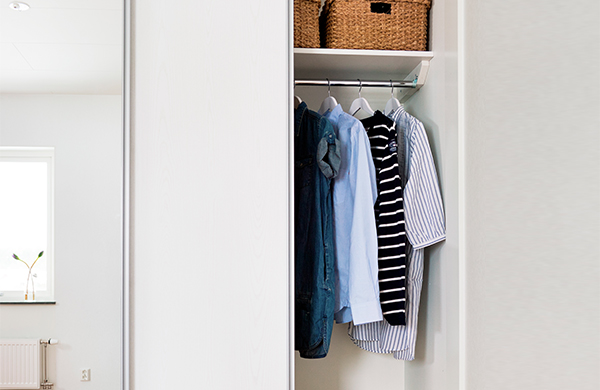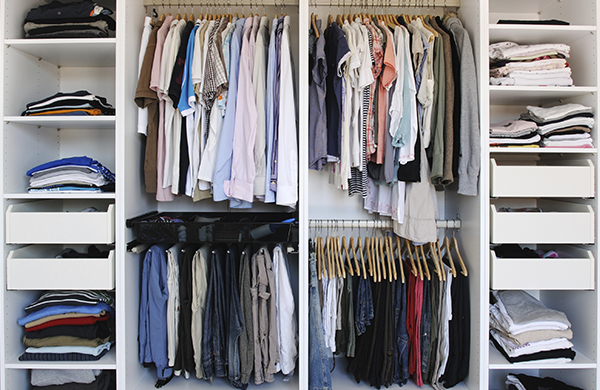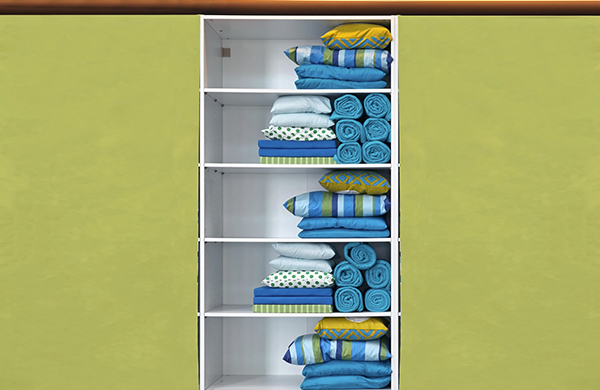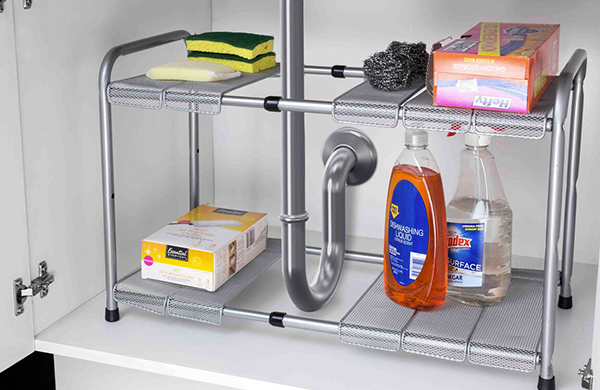
Closets are meant to be helpful spaces to store stuff so your floors stay clear and your underbed monster has plenty of room to stretch out. If yours seem to swallow everything you put in them under a sea of clutter, it’s time for some closet organization.
With a smart combination of preparation, purging, and the right organizers, you can easily reclaim your space. Read on for our step-by-step organization tips for bedroom, linen, and utility storage.
Bedroom Closet
If You’re Short on Space
Clothes Out
If you don’t have enough closet space for your attire, there’s an easy solution: pare down your clothes. (Bonus: an edited wardrobe will make getting dressed in the morning quicker.)
Start by removing all of the clothing, shoes, and accessories from your closet, then sort each into one of four piles:
- I love it and would wear it right this minute. This is the stuff you’ll definitely keep.
- Ehh, maybe. Put this pile into storage, perhaps in the garage or under a bed. If you don’t take it out in six months or a year, you don’t need it.
- This isn’t the season for it, but I’ll definitely wear it within the year. We’re talking winter coats in June and short shorts in January. These items also go into storage.
- Nope. Sell, donate, trade, or toss it! Trust yourself and don’t dwell too much on what goes in this pile: most likely, you’ll know deep in your gut whether something should be kept.
Hooks, Hangers, and Shelving, Oh My
Once you’re down to the clothes you’re keeping, it’s time to put everything in its rightful place. A few key purchases can make it easier:
- Hangers: Replace your mishmash of old hangers with a new matching set, and you’ll be surprised how much more space you have to work with. Try “huggable” hangers to keep clothes really compact, and look for cascading models to hang several items in the space of a single hanger.
- Hooks: S-hooks wide enough for a closet rod are ideal for storing jeans, belts, handbags, and other hangable items. Wall-mounted hooks are great for installing on the back of a closet door for extra storage space, or on the front for a convenient place to hang the clothes you plan to wear again before laundry day.
- Shelves: Hanging fabric shelves can provide ample space for sweaters, trousers, and other folded items in the space of just a few hangers. If there’s already a shelf in your closet, under-shelf baskets can slide right beneath them to add another level of storage.

If There’s Truly No More Room
If you’ve tried everything above and your closet still runneth over, focus your efforts on the rest of the bedroom. A wide variety of furniture doubles as storage—think storage ottomans and benches, which can provide stylish seating while concealing last season’s sweater collection. Under-bed storage bins are designed to be shallow enough to slide smoothly beneath most bed frames. With a few fabric bins and shelf dividers, even bookshelves can be repurposed for clothing storage, and of course, there’s always the option to get a second, free-standing closet or wardrobe.

Linen Closet
If You’re Short on Space
Divide and Bundle
Often, the biggest reason a linen closet bursts at the seams is a lack of organization. Start your organizational journey by taking everything out and starting fresh. Next:
- Keep only what you need. Experts recommend limiting the household to three sheet sets per bed and three towel sets—that is, bath towel, hand towel, and washcloth—per person. Think of it as having one set in use, one set in the hamper, and one set in the closet ready to go.
- Roll and stack your towels. This maximizes space and makes it easier to take out towels on the bottom without disturbing the ones on top.
- Bundle your sheets. Sheet sets come with their own storage container: a pillowcase. Fold the top sheet, the fitted sheet, and one pillowcase, then place them all inside the second pillowcase. Click here to learn how to fold a fitted sheet.
Contain Yourself
All the little bottles and tubes and packages that end up in the linen closet are most at risk when it comes to closet avalanches. To keep them contained, you can splurge on a set of matching baskets, fabric boxes, or clear plastic tubs. For bonus points, label your vessel of choice by category: skincare, dental care, and cleaning products, for example. Small standalone chests of drawers are also handy for tinier items such as cosmetics, toothbrushes, and cotton swabs.
If There’s Truly No More Room
If your linen closet is still too small—or, worse, if you don’t have one at all—you still have options. Consider adding an over-the-toilet organizer for extra shelves and cabinet space, along with under-sink organizers to give those cabinets more surface area. If they’re eye-catching enough, the same baskets and boxes we recommended for the closet can be used on the countertop for extra storage and easy access. You can even try some unorthodox solutions: wine-bottle racks can also hold rolled-up bath towels, and storage baskets can be altered to hang from towel rods.

Utility Closet
If You’re Short on Space
Pare Down and Plan Out
By now, you know the drill: the first step to having more space is having fewer things. For the utility closet, this is a three-step process:
- Take stock of your cleaning supplies and other household products. Throw away anything that’s expired, nearly empty, or a duplicate of a product you forgot you had.
- Remove anything that doesn’t belong. As often as we break this rule, the utility closet should be a place for household supplies and tools only—not a catch-all location for excess dinnerware, defunct time-travel devices, and other things you don’t have a place for. (Pro tip: not having a place for something is often a good sign you don’t need it.)
- Find a place for the vacuum. In most homes, the vacuum is the utility closet’s largest occupant. Once you have a place for this hefty appliance, you can plan your organizing around it.
Easy to See, Easy to Reach
Even if you’re no longer using the utility closet for uncategorized odds and ends, it’s most likely full of a bogglingly wide variety of tools and products. This can make finding the item you need a challenge. To overcome this, put as much as possible in full view and at arm’s reach.
Matching bins or boxes can keep cleaning products separate from home-improvement supplies, and labels can make them easy to identify the moment you open the closet door. Under-shelf baskets and hanging bins are great for easy, eye-level access, as are over-the-door shoe organizers, which can double as cleaning-product storage. Wall-mounted hooks—or, for the full nine yards, a pegboard—can hang hammers, dustpans, scissors, and other tools, while snap-lock organizers designed for brooms and mops can keep those implements from toppling out the door.
If There’s Truly No More Room
If your utility closet isn’t even large enough to hold a vacuum, much less every cleaning product you own, it’s time to get creative. Try placing the vacuum and/or brooms and mops, if necessary, behind a curtain or a large piece of furniture, such as a floor mirror, a bureau, or an entertainment center.
If you have a garage or a porch, consider stashing anything that can stand the temperature fluctuations there (think brooms, dust rags, buckets, and their ilk). If you don’t have a space, there’s a wide variety of outdoor storage solutions, from chests to sheds.






